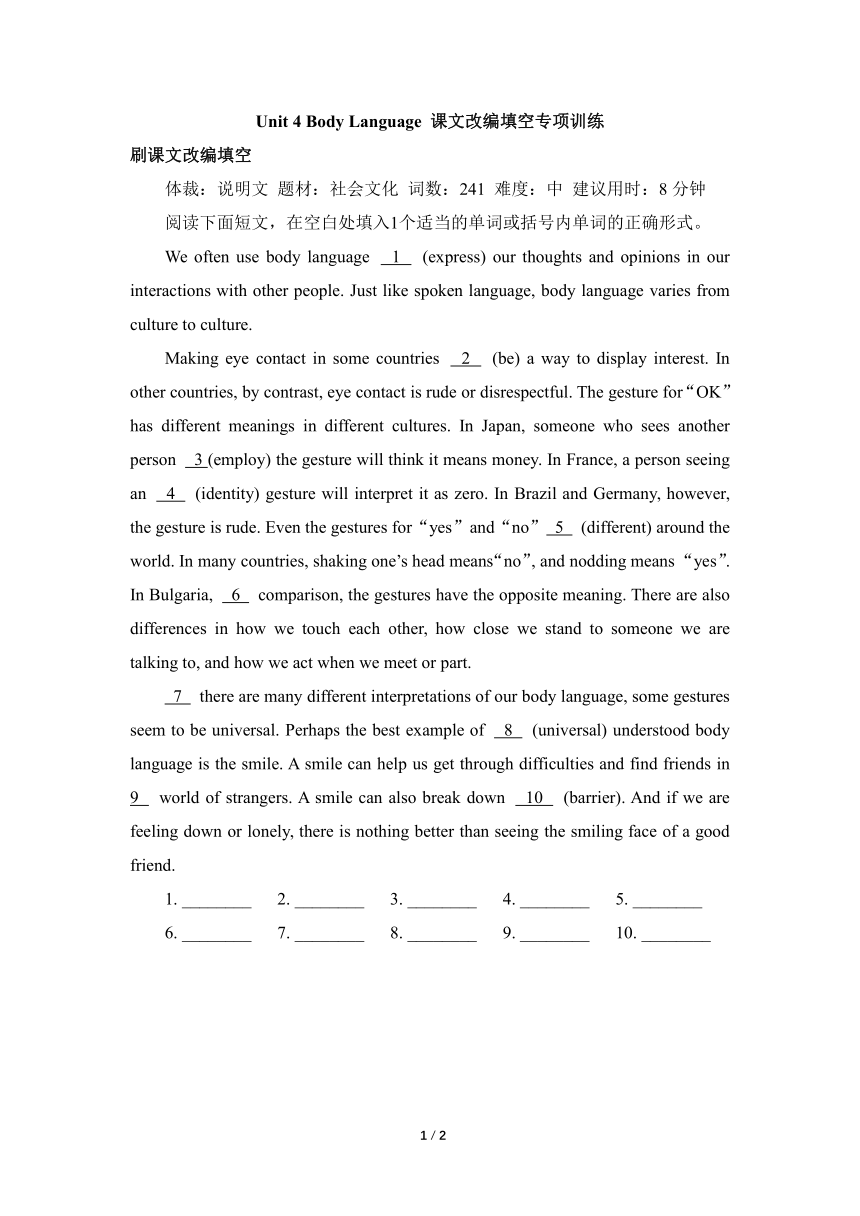人教版(2019)选择性必修第一册 Unit4 Body Language 课文改编填空专项训练(含答案和解析)
文档属性
| 名称 | 人教版(2019)选择性必修第一册 Unit4 Body Language 课文改编填空专项训练(含答案和解析) |  | |
| 格式 | docx | ||
| 文件大小 | 14.7KB | ||
| 资源类型 | 教案 | ||
| 版本资源 | 人教版(2019) | ||
| 科目 | 英语 | ||
| 更新时间 | 2023-03-11 20:43:14 | ||
图片预览

文档简介
Unit 4 Body Language 课文改编填空专项训练
刷课文改编填空
体裁:说明文 题材:社会文化 词数:241 难度:中 建议用时:8分钟
阅读下面短文,在空白处填入1个适当的单词或括号内单词的正确形式。
We often use body language 1 (express) our thoughts and opinions in our interactions with other people. Just like spoken language, body language varies from culture to culture.
Making eye contact in some countries 2 (be) a way to display interest. In other countries, by contrast, eye contact is rude or disrespectful. The gesture for“OK” has different meanings in different cultures. In Japan, someone who sees another person 3 (employ) the gesture will think it means money. In France, a person seeing an 4 (identity) gesture will interpret it as zero. In Brazil and Germany, however, the gesture is rude. Even the gestures for“yes”and“no” 5 (different) around the world. In many countries, shaking one’s head means“no”, and nodding means “yes”. In Bulgaria, 6 comparison, the gestures have the opposite meaning. There are also differences in how we touch each other, how close we stand to someone we are talking to, and how we act when we meet or part.
7 there are many different interpretations of our body language, some gestures seem to be universal. Perhaps the best example of 8 (universal) understood body language is the smile. A smile can help us get through difficulties and find friends in 9 world of strangers. A smile can also break down 10 (barrier). And if we are feeling down or lonely, there is nothing better than seeing the smiling face of a good friend.
1. ________ 2. ________ 3. ________ 4. ________ 5. ________
6. ________ 7. ________ 8. ________ 9. ________ 10. ________
答案解析:
刷课文改编填空
1. to express设空处应用非谓语形式,our pinions在句中作目的状语,故设空处应用不定式形式。
2. is 单个动名词(短语)作主语时,谓语动词应用单数形式。故填is。
3. employing see sb doing sth意为“看见某人正在做某事”。故填employing。
4. identical 设空处修饰名词 gesture,作定语,应用形容词。identical意为“同样的;完全相同的”。
5. differ此处是谓语,所以应用动词形式。本句陈述一般事实,且主语 the gestures为复数形式,故填 differ。
6. by by comparison意为“相比之下”。
7. While/Although/Though 句意为:虽然我们的肢体语言有许多不同的解释,但有些似乎是通用的。设空处表示让步,故可填 While Although或 Though。
8. universally 设空处修饰分词 understood,应用副词。故填universally。
9. a 此处泛指“一个充满陌生人的世界”,应用不定冠词。故填a。
10. barriers barrier是可数名词,此处是指很多障碍,所以应用复数形式。
2 / 2
刷课文改编填空
体裁:说明文 题材:社会文化 词数:241 难度:中 建议用时:8分钟
阅读下面短文,在空白处填入1个适当的单词或括号内单词的正确形式。
We often use body language 1 (express) our thoughts and opinions in our interactions with other people. Just like spoken language, body language varies from culture to culture.
Making eye contact in some countries 2 (be) a way to display interest. In other countries, by contrast, eye contact is rude or disrespectful. The gesture for“OK” has different meanings in different cultures. In Japan, someone who sees another person 3 (employ) the gesture will think it means money. In France, a person seeing an 4 (identity) gesture will interpret it as zero. In Brazil and Germany, however, the gesture is rude. Even the gestures for“yes”and“no” 5 (different) around the world. In many countries, shaking one’s head means“no”, and nodding means “yes”. In Bulgaria, 6 comparison, the gestures have the opposite meaning. There are also differences in how we touch each other, how close we stand to someone we are talking to, and how we act when we meet or part.
7 there are many different interpretations of our body language, some gestures seem to be universal. Perhaps the best example of 8 (universal) understood body language is the smile. A smile can help us get through difficulties and find friends in 9 world of strangers. A smile can also break down 10 (barrier). And if we are feeling down or lonely, there is nothing better than seeing the smiling face of a good friend.
1. ________ 2. ________ 3. ________ 4. ________ 5. ________
6. ________ 7. ________ 8. ________ 9. ________ 10. ________
答案解析:
刷课文改编填空
1. to express设空处应用非谓语形式,our pinions在句中作目的状语,故设空处应用不定式形式。
2. is 单个动名词(短语)作主语时,谓语动词应用单数形式。故填is。
3. employing see sb doing sth意为“看见某人正在做某事”。故填employing。
4. identical 设空处修饰名词 gesture,作定语,应用形容词。identical意为“同样的;完全相同的”。
5. differ此处是谓语,所以应用动词形式。本句陈述一般事实,且主语 the gestures为复数形式,故填 differ。
6. by by comparison意为“相比之下”。
7. While/Although/Though 句意为:虽然我们的肢体语言有许多不同的解释,但有些似乎是通用的。设空处表示让步,故可填 While Although或 Though。
8. universally 设空处修饰分词 understood,应用副词。故填universally。
9. a 此处泛指“一个充满陌生人的世界”,应用不定冠词。故填a。
10. barriers barrier是可数名词,此处是指很多障碍,所以应用复数形式。
2 / 2
